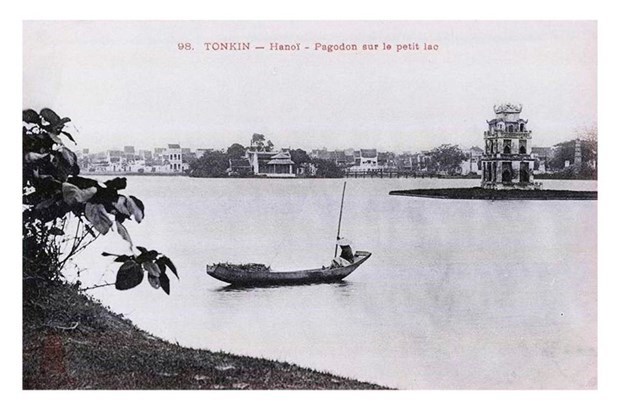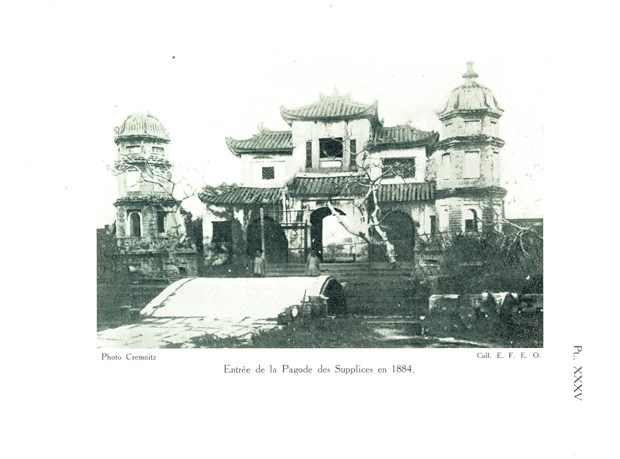Document exhibition features Hoan Kiem Lake in 19th century
 Ho Guom (Hoan Kiem Lake) Square in the period of French domination. (Photo: National Archives Centre I)
Ho Guom (Hoan Kiem Lake) Square in the period of French domination. (Photo: National Archives Centre I)Hanoi (VNA) – Nearly 100 photos and documents featuring Hanoi in the 19th century will be displayed online by the National Archives Centre I under the State Records and Archives Management Department on October 8.
The online exhibition, titled "Ho Guom, Giao Lo Dong Tay" (Sword Lake, East-West Intersection), will be available on the website of the National Archives Centre 1, archives.org.vn, and its Facebook page, facebook.com/luutruquocgia1.
It is part of the activities to celebrate the 67th anniversary of the capital city's liberation day (October 10, 1954 - 2021).
It will feature familiar images of the daily life of Hanoians in general, particularly people in the area around Hoan Kiem Lake. It will also display works built by the French and many other historical and cultural landscapes and monuments. There will be three themes: The process of changing the appearance of Sword Lake; Preserving historical and cultural space of Sword Lake; and Sword Lake - Service and cultural centre.
More than 100 documents, images and drawings that will be introduced at the exhibition are just a fraction of the many documents about Hanoi currently preserved at the National Archives Centre I.
The exhibition intends to arouse public nostalgia for Hoan Kiem Lake and old Hanoi.
Hoan Kiem Lake, a vestige of an ancient Nhi Ha River, is a famous scenic site of the capital. It is surrounded by Hang Khay Street, Le Thai To Street and Dinh Tien Hoang Street.
With its prime location, Hoan Kiem Lake was chosen by the French colonists to become the centre of the renovation of Hanoi city when they arrived in this land.
Under the planning of the French colonists, Hoan Kiem Lake is like an intersection that connects Eastern and Western architectural and cultural sentiments.
Along with the old habits and the traditional living habits of Hanoians, the new look of a Western urban area has made the lifestyle of the people more modern. That resonance has created a very unique mark for Hoan Kiem Lake and the Hanoi's Old Quarter today.
In 1873, the Hue court zoned off 2.5ha of land in Don Thuy next to the Red River to build residence for the French envoy. Construction began in October 1875, with the main road being what is now Pham Ngu Lao Street. At that time, Hoan Kiem Lake was still a rural area.
 Hoan Kiem Lake in the 19th century (Photo: National Archives Centre I)
Hoan Kiem Lake in the 19th century (Photo: National Archives Centre I)Since 1884, Hoan Kiem Lake had become a centre of Hanoi’s planning work. The French colonists opened a route connecting the French envoy’s residence with Thang Long Royal Citadel.
The French quarter was gradually completed between October 1886 and 1888, starting from Paul Bert-des Inscruteurs (Trang Tien-Hang Khay-Trang Thi), to Francis Garnier (Dinh Tien Hoang) and Beauchamps (Le Thai To), along with parallel streets around Hoan Kiem Lake.
Starting in 1897, the French strengthened the city’s infrastructure by paving and consolidating roads, completing electricity and water supply systems, and expanding a number of markets, railway stations, squares, parks and cinemas. A couple of notable examples are the Bo Ho Power Plant (1899-1902) and the Hanoi Electric Train Company (1900).
 Bao An Pagoda in 1884 (Photo: National Archives Centre I)
Bao An Pagoda in 1884 (Photo: National Archives Centre I) The construction of offices and the master plan in the eastern part of Hoan Kiem turned the area into a centre of politics, religion, trade, services, culture and entertainment of Hanoi.
However, France destroyed a number of pagodas around Hoan Kiem Lake to facilitate this construction, triggering outrage of not only local residents but also French officials.
Because of this, the Governor-General of French Indochina signed decrees on March 9,1900 and April 15, 1905 to preserve the history of the city.
Hoan Kiem Lake and its adjacent areas are now home to historical, cultural, artistic and architectural sites such as Ngoc Son Temple, The Huc Bridge, Hoa Phong Tower, Turtle Tower and Pen Tower./.













